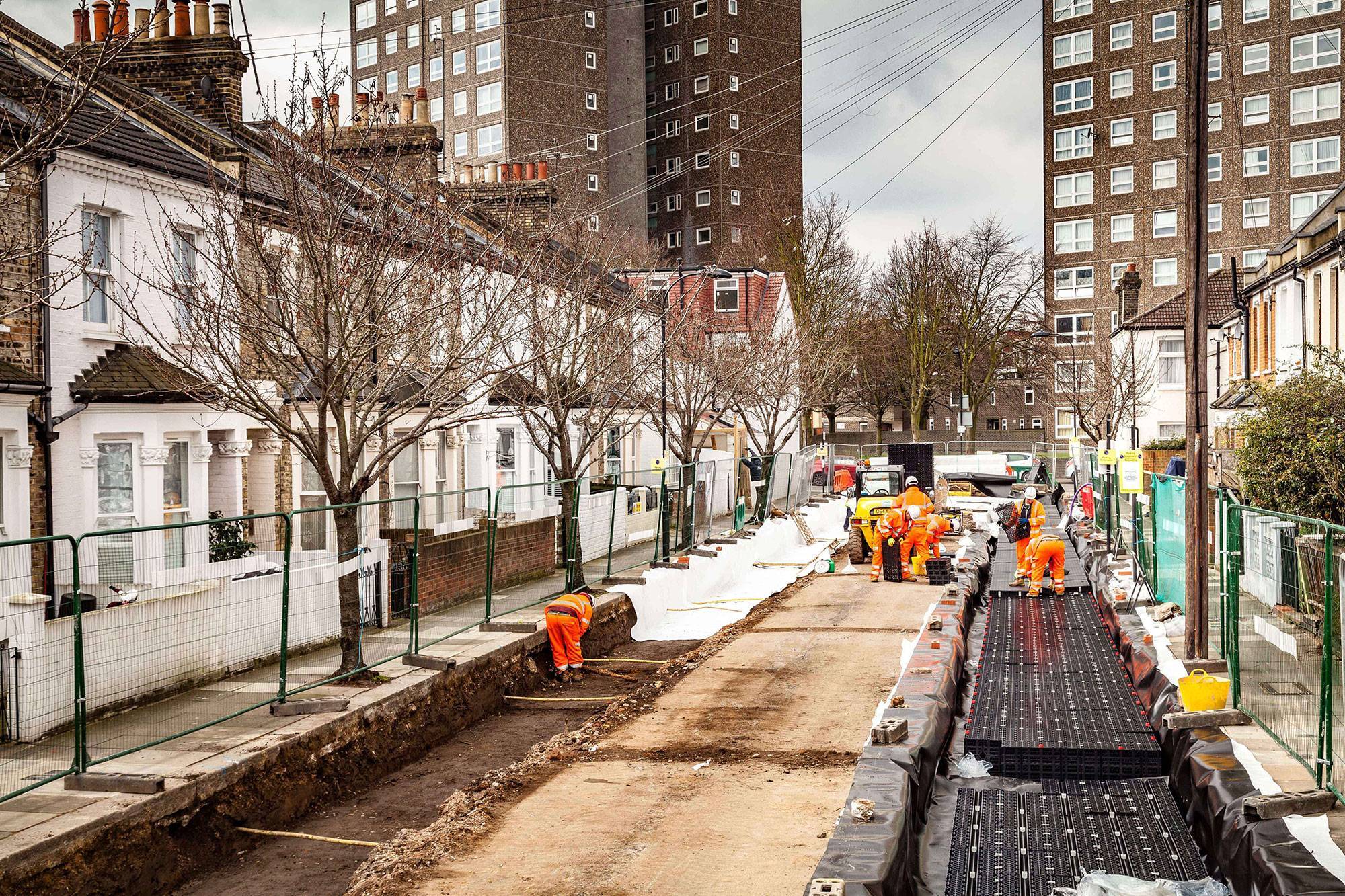Polypipe Provides Flood Alleviation for Retrofit Scheme at ‘Lost’ London River
Tuesday 13th December 2016

An ambitious scheme designed to combine engineered and soft SuDS solutions to alleviate the risk of flooding from west London’s combined sewers has seen Polypipe’s Permavoid system used to create two unique shallow stormwater drainage systems that are sensitive to their environment. A third scheme will begin this autumn using Polypipe’s Permavoid system to complete the project.
The project, overseen by Thames Water in partnership with the London Borough of Hammersmith and Fulham and the Royal Borough of Kensington and Chelsea, will see SuDS solutions retrofitted into a highly urbanised area, in order to potentially mitigate the risk of surface water flooding during periods of heavy rainfall across the Counters Creek catchment area.

One of London’s lost rivers, Counters Creek once flowed through the region before being culverted in the 19th century to form part of Joseph Bazalgette’s new sewer network, made necessary due to an increasing population in London. With further building work heavily urbanising the area featuring many properties with basement levels, the two local authorities and Thames Water have worked together to create the SuDS scheme sites which will be used to monitor performance.
This approach is important since the Counters Creek catchment area lost almost a fifth of its permeable green space between 1971 and 2007 due to urbanisation and no local open watercourses remain. This increased the risk of the local sewer network flooding due to an increase in surface water run-off.
In order to assess the varied approaches SuDS can offer, the project saw three scheme sites identified where a number of differing surface water management systems could be utilised in combination with their surroundings. The three ‘typical’ London streets selected met Thames Water’s criteria of being hydraulically discrete and having suitable monitoring points to measure the system’s effectiveness.
The SuDS scheme retrofitted in the three streets of the two boroughs will limit, as far as possible, the volume and rate at which surface water enters the public sewer system. Monitoring performance in the three streets should provide evidence to show whether these systems provide a viable solution that could be applied across a wider area.
Polypipe’s Permavoid geocellular system was used to create part of an engineered stormwater solution for each of the selected locations: Mendora Road in Fulham, Melina Road in Shepherd’s Bush and Arundel Gardens in Kensington. These three separate solutions have been developed with specific focus on their particular environment. The two streets in the London Borough of Hammersmith and Fulham have been constructed in collaboration with the borough council, their contractors FM Conway, SEL Environmental, consultant AECOM, and with the final designs reviewed by chosen consultant engineering firm ATKINS. The retrofitted SuDS scheme at Arundel Gardens in the Royal Borough of Kensington and Chelsea will be built this autumn in collaboration with the council and their contractors.
Harnessing its innate strength and 95% void fill ratio, Permavoid was used beneath permeable paving under both sides of Mendora Road, a typical suburban street in the region. The 3,600 Permavoid cells form an attenuation solution providing 136m³ of stormwater storage. Due to its location directly beneath residents’ cars, Permafilter geomembrane was also specified beneath the permeable paving in order to treat any stormwater contaminated by oils and pollutants from vehicles before the water enters the storage tank.
The scheme also saw 2,345 Permavoid cells employed to create four separate storage tanks beneath rain gardens at Melina Road. Each of the tanks featured Permavoid Permafoam cells to upwardly irrigate the planters and rain gardens above. Wrapped in a Permavoid Permatex Capillary Geotextile, the cells collect rainwater and provide ‘on demand’ irrigation for vegetation. This technique mitigates flood risk during storm events while sustaining plant growth and providing additional green space in an urban environment.
The third further environmentally sensitive system design incorporated as part of the project will see Permavoid installed beneath the road surface of Arundel Gardens, with the established magnolia trees on each side of the road benefitting from a passive watering system that uses some of the stored rainwater from within the attenuation crates.
Martin Bennett, Project Director of the Counters Creek Sewer Flooding Alleviation Scheme said: “The implementation of the SuDS solutions marks an important milestone in the delivery of the wider project which will help alleviate the misery of sewer flooding for local residents.
“Together with the proposed storm relief tunnel which will run under both local authority areas, upgrading the existing local sewer network and the SuDS schemes, the ability of the sewer network to cope with heavy rainfall will be greatly improved and we are delighted that in this instance we have been able to work collaboratively to provide such an innovative solution.”
Sean Robinson, Permavoid Project Manager at Polypipe comments: “The project is an ideal opportunity to measure the effectiveness of urban retrofit possibilities. The solution is also extremely sympathetic to maintaining the quality of life of residents living in and around the scheme while existing green space has been preserved and even created through the use of Permavoid to enhance the biodiversity of some the locations. It is great that an opportunity like this has actively showcased the technology and solutions with the local community.
Work on the project is expected to be completed in early 2017.
For more information on Polypipe and its range of solutions, visit www.polypipe.com/wms
To learn more about Counters Creek visit http://www.thameswater.co.uk/counterscreek/


